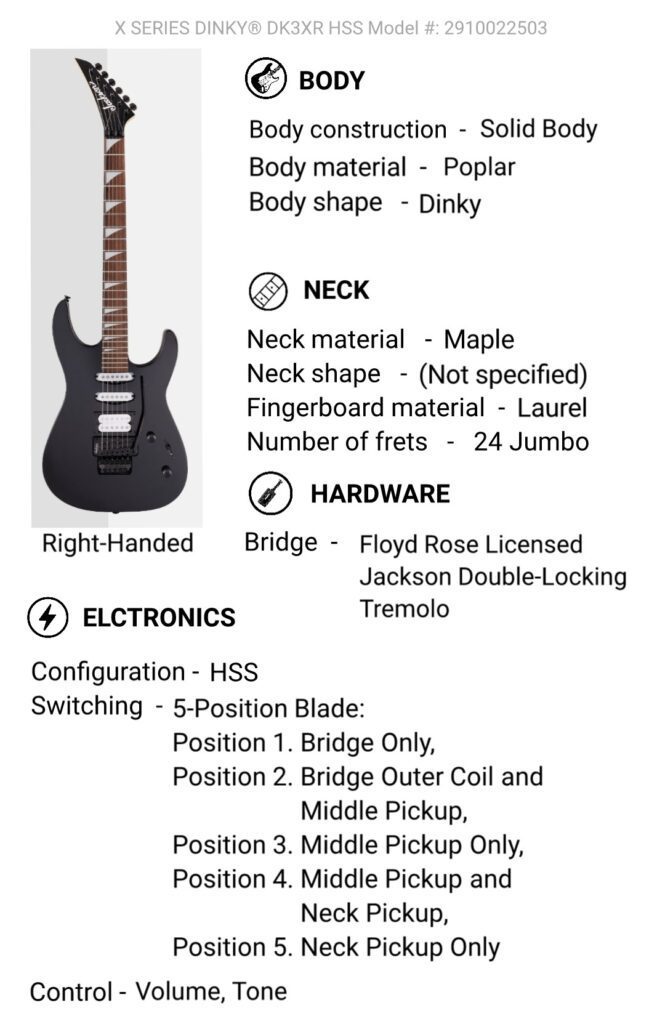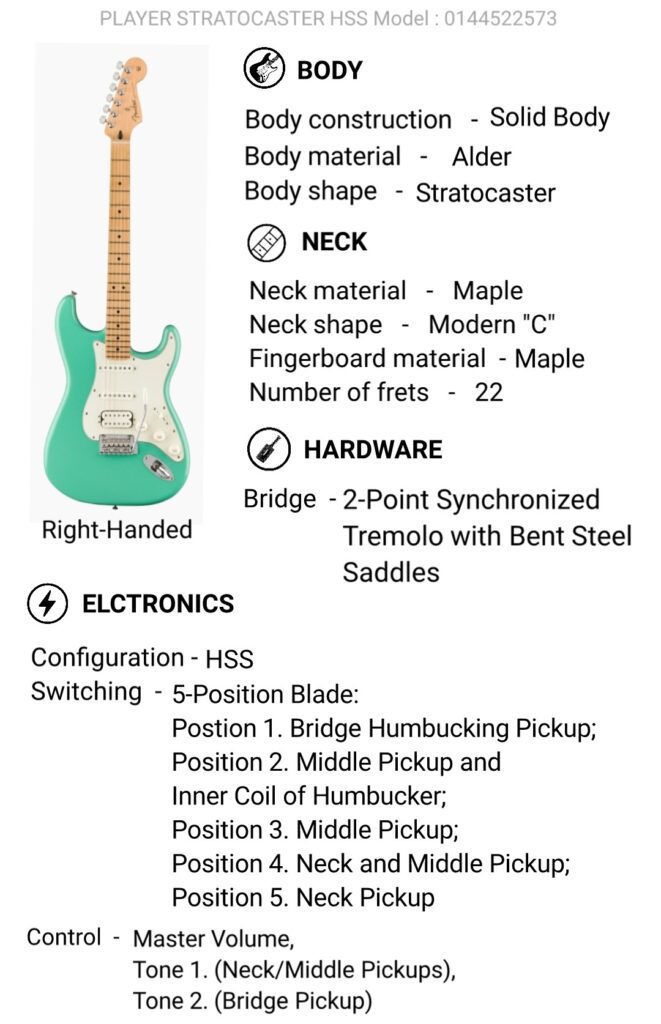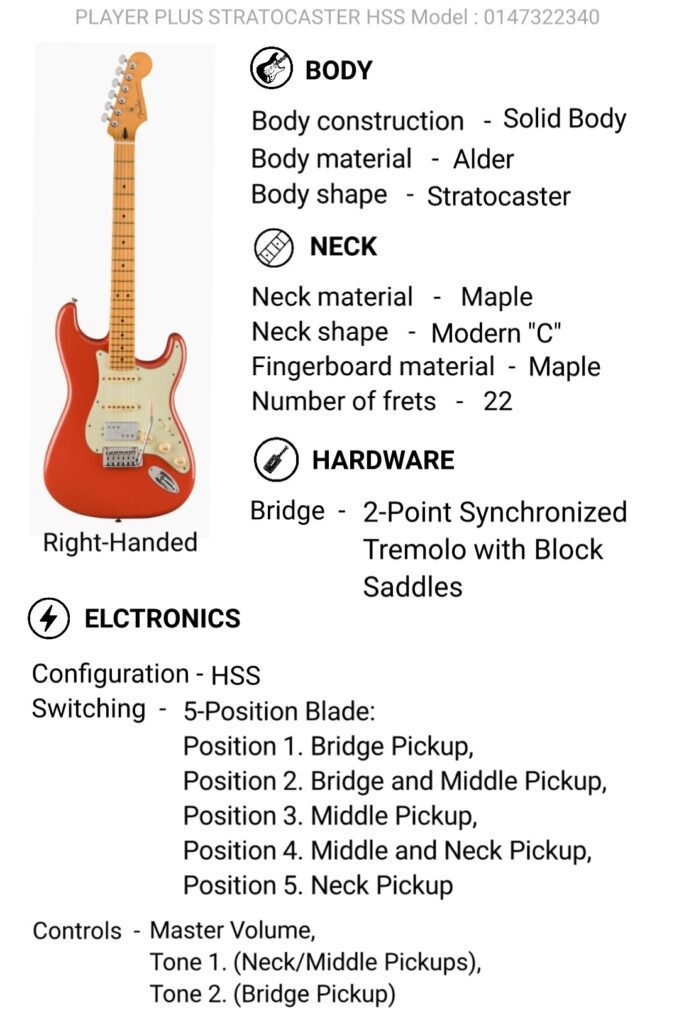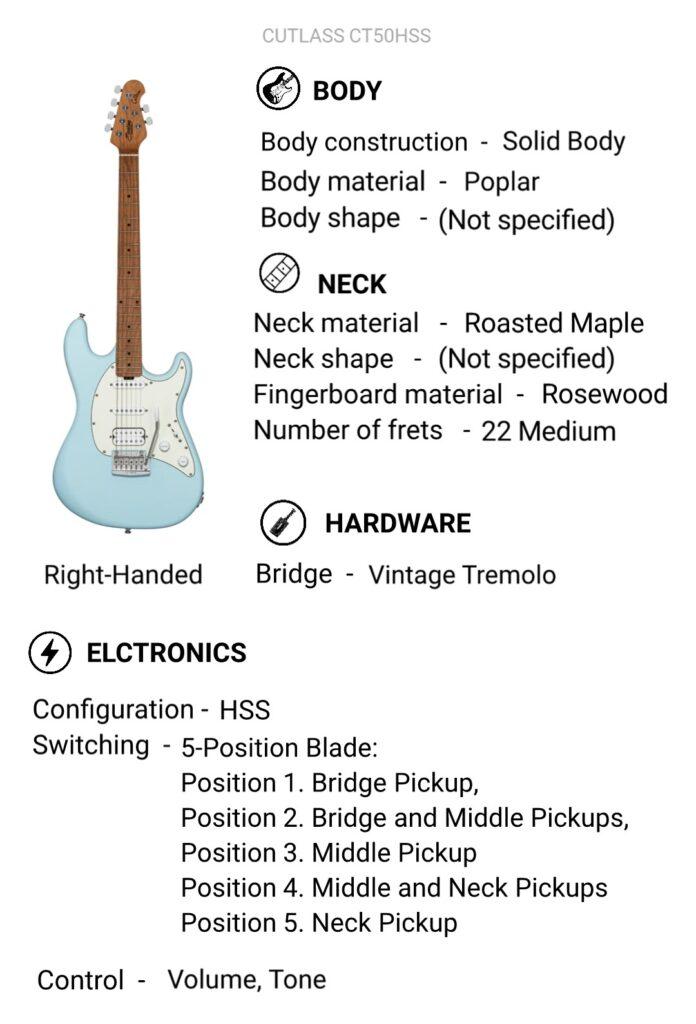List of Best HSS (humbucker single-coil single-coil) electric guitar with features and specifications, You can compare electric guitar
prices on different online stores.
Godin Session R-HT Pro Carbon White

Charvel Pro-Mod DK24 HSS FR E

EVH Striped Series Frankenstein Frankie

Jackson X Series Dinky DK3XR HSS

Read More
 Amazon.in
Amazon.in  ₹ 60,100
₹ 60,100  Go To Store
Go To Store
 Amazon.in
Amazon.in  ₹ 60,100
₹ 60,100  Go To Store
Go To Store
 Amazon.com
Amazon.com  $ 726
$ 726  Go To Store
Go To Store
 Amazon.com
Amazon.com  $ 726
$ 726  Go To Store
Go To Store
 Guitar Center
Guitar Center  $ 599
$ 599  Go To Store
Go To Store
 Guitar Center
Guitar Center  $ 599
$ 599  Go To Store
Go To Store
 Thomann
Thomann  $ 515
$ 515  Go To Store
Go To Store
 Thomann
Thomann  $ 515
$ 515  Go To Store
Go To Store
Schecter Nick Johnston Traditional H/S/S

Read More
 Amazon.in
Amazon.in  ₹ 89,269
₹ 89,269  Go To Store
Go To Store
 Amazon.in
Amazon.in  ₹ 89,269
₹ 89,269  Go To Store
Go To Store
 Amazon.com
Amazon.com  $ 1078
$ 1078  Go To Store
Go To Store
 Amazon.com
Amazon.com  $ 1078
$ 1078  Go To Store
Go To Store
 Guitar Center
Guitar Center  $ 899
$ 899  Go To Store
Go To Store
Banshee-6 FR SGR by Schecter

Ibanez GRX40
Ibanez GSA60

Ibanez SA260FM
Yamaha Pacifica 112J

Yamaha Pacifica 012

Fender Player Stratocaster HSS

Fender Classic Vibe 70s Stratocaster HSS

Fender Player Plus Stratocaster HSS

Fender American Performer Stratocaster HSS

Introduction: The HSS (Humbucker-Single Coil-Single Coil) electric guitar configuration stands as a testament to versatility, offering a balance between the warmth of humbucking pickups and the clarity of single coils. This popular pickup layout has become a favorite among guitarists of various styles, thanks to its ability to cover a wide range of tones, from crisp cleans to aggressive distortion. In this article, we delve into the features, benefits, and history of the HSS electric guitar.
”Read_More”
Features and Configuration: The HSS configuration typically features a humbucking pickup in the bridge position, offering high-output, fat tones with reduced noise and interference. Paired with two single-coil pickups in the middle and neck positions, the guitar achieves a diverse tonal palette that caters to different playing styles and musical genres. This setup provides the flexibility to dial in warm, punchy rhythm tones from the neck pickup, sparkling cleans from the middle pickup, and thick, aggressive lead tones from the bridge humbucker.
Balanced Tone and Sonic Character: The combination of humbucker and single-coil pickups in an HSS configuration results in a balanced tonal profile with rich lows, clear mids, and smooth highs. This balanced sonic character makes HSS guitars well-suited for both rhythm and lead playing, allowing the instrument to cut through the mix in a band setting while retaining clarity and definition. Whether you’re strumming chords, playing melodic lines, or unleashing blistering solos, the HSS guitar offers the tonal versatility and dynamic range to adapt to any musical situation.
Conclusion: In conclusion, the HSS electric guitar configuration embodies the perfect balance between versatility, tone, and performance. With its combination of humbucker and single-coil pickups, the HSS guitar offers a diverse array of tones that cater to the needs of players across different genres and musical contexts.
For which Genres of music is the HSS pickup configuration suitable?
The HSS (Humbucker-Single Coil-Single Coil) pickup configuration is suitable for a wide range of musical genres due to its versatile tonal capabilities. Here’s an explanation of its suitability for various genres:
- Rock and Hard Rock: The HSS configuration is particularly well-suited for rock and hard rock genres. The humbucker in the bridge position provides the thick, high-output tones needed for powerful rhythm playing and searing lead solos. It delivers rich, saturated distortion with ample sustain, making it ideal for aggressive riffing and soaring leads. The single-coil pickups offer additional clarity and bite, allowing for dynamic rhythm work and articulate lead lines.
- Blues and Blues Rock: For blues and blues rock styles, the HSS configuration excels at delivering warm, expressive tones. The neck and middle single-coil pickups produce smooth, bell-like cleans with a touch of twang, perfect for emotive blues phrasing and soulful lead playing. Switching to the bridge humbucker adds grit and punch, ideal for injecting bluesy bends and gritty overdriven tones into your playing.
- Pop and Pop-Rock: In pop and pop-rock music, versatility is key, and the HSS configuration offers just that. The single-coil pickups deliver bright, chiming cleans that cut through the mix, providing the sparkle and shimmer needed for catchy pop melodies and hooks. When driven harder, the humbucker adds depth and warmth, enhancing the overall richness of the sound and providing a solid foundation for pop-rock rhythm sections.
- Funk and R&B: The HSS setup is also well-suited for funk and R&B styles, where clarity and punch are essential. The middle and neck single-coil pickups offer tight, percussive tones with plenty of bite, perfect for funky rhythm playing and staccato chord accents. Switching to the bridge humbucker adds thickness and weight to the sound, allowing for fat, punchy grooves and smooth, soulful leads.
- Country and Country Rock: While not as common in traditional country music, the HSS configuration can still find its place in country and country rock genres. The single-coil pickups deliver twangy, twirling cleans reminiscent of classic country tones, while the humbucker adds warmth and body, perfect for modern country-rock stylings with a bit of edge and grit.
Overall, the HSS pickup configuration offers a versatile sonic palette that can adapt to a wide range of musical genres and playing styles. Whether you’re rocking out on stage, laying down soulful grooves in the studio, or serenading audiences with heartfelt blues licks, the HSS guitar provides the tonal flexibility and dynamic range to excel in any musical context.
How to choose right HSS electric Guitar
Choosing the right HSS (Humbucker-Single Coil-Single Coil) electric guitar involves considering several factors to ensure it meets your musical preferences and performance needs. Here’s a guide to help you select the perfect HSS guitar:
- Define Your Playing Style: Determine the musical genres and playing styles you most commonly engage in. Whether you play rock, blues, pop, funk, or other genres will influence the specific features you’ll want in your HSS guitar.
- Consider Tonewood and Construction: Different tonewoods and construction methods can significantly impact the guitar’s tone and resonance. Research the tonal characteristics of woods like alder, ash, mahogany, and maple to find the combination that best suits your preferences.
- Pickup Configuration and Wiring Options: While all HSS guitars feature a humbucker in the bridge position and single coils in the middle and neck positions, the specific pickups and wiring options can vary. Some guitars offer coil-splitting or coil-tapping options, allowing you to achieve single-coil tones from the humbucker for added versatility.
- Playability and Neck Profile: Pay attention to the guitar’s playability, including the neck profile, fretboard radius, and scale length. Choose a neck profile and fretboard radius that feels comfortable in your hands and facilitates your playing technique, whether it’s fast shredding or smooth chord transitions.
- Hardware and Electronics: Consider the quality of the hardware and electronics, including the bridge, tuners, and controls. High-quality hardware ensures stable tuning and reliable performance, while premium electronics can enhance the guitar’s tonal versatility and clarity.
- Budget and Value: Set a budget for your guitar purchase and consider the overall value offered by different models. Determine which features are essential for your playing needs and find a guitar that offers the best combination of quality, features, and affordability within your budget.
- Test Play and Listen: Whenever possible, try out different HSS guitars in person to assess their sound, playability, and comfort. Play various musical passages to gauge how the guitar responds to different playing styles and techniques. Additionally, listen to how the guitar sounds through different amplifiers to ensure it delivers the tone you desire.
- Research and Reviews: Take the time to research various HSS guitar models online and read reviews from other players. Pay attention to feedback regarding build quality, tone, playability, and overall satisfaction to help inform your decision.
Pros and Cons HSS electric Guitars
By considering these factors and thoroughly researching your options, you can choose the right HSS electric guitar that meets your musical preferences, performance needs, and budgetary constraints.
Pros:
- Versatility: HSS guitars offer a versatile range of tones suitable for various musical genres, from rock and blues to pop and funk. The combination of a humbucker and single-coil pickups provides a wide sonic palette, allowing players to dial in everything from warm, fat tones to crisp, clear cleans.
- High-Output Bridge Pickup: The humbucker in the bridge position delivers high-output, powerful tones with enhanced sustain and reduced noise, making it ideal for aggressive rhythm playing and searing lead solos in rock and metal styles.
- Clarity and Definition: The single-coil pickups in the middle and neck positions provide clarity and articulation, ensuring that individual notes and chords cut through the mix with precision. This clarity is especially useful for clean passages, intricate lead lines, and funky rhythm playing.
- Balanced Tone: HSS guitars offer a balanced tonal profile with rich lows, clear mids, and sparkling highs, thanks to the combination of humbucker and single-coil pickups. This balanced tone allows the guitar to excel in both rhythm and lead playing across a wide range of musical styles.
- Dynamic Range: With the ability to switch between the humbucker and single-coil pickups, HSS guitars offer a wide dynamic range that caters to different playing styles and musical contexts. Players can easily transition from smooth, soulful cleans to aggressive, overdriven tones with the flick of a switch.
Cons:
- Limited Single-Coil Tonal Options: While HSS guitars offer the versatility of both humbucker and single-coil pickups, some players may find the single-coil tones lacking compared to guitars with dedicated single-coil configurations. The single-coil pickups in an HSS setup may not deliver the same level of clarity and sparkle as those found in SSS (Three Single-Coils) guitars.
- Potential Noise Issues: Despite the noise-reducing properties of humbucking pickups, HSS guitars may still be susceptible to noise and interference, particularly when using high-gain settings or playing in environments with electromagnetic interference. Players may need to use noise gates or other noise-suppression techniques to mitigate these issues.
- Complex Wiring and Pickup Switching: The additional pickup and switching options in HSS guitars can lead to more complex wiring configurations, which may be intimidating for players who are not familiar with guitar electronics. Understanding how to navigate the pickup selector switch and coil-splitting options may require some experimentation and practice.
- Bridge Pickup Dominance: In some HSS guitars, the humbucker in the bridge position may overpower the single-coil pickups, resulting in an imbalanced tone that favors aggressive, high-gain sounds. Players who prefer the clarity and brightness of single-coil tones may find it challenging to achieve a balanced sound with the bridge humbucker in certain HSS configurations.
Overall, HSS electric guitars offer a versatile combination of tones suitable for a wide range of musical styles and playing techniques. While they may have some drawbacks compared to guitars with dedicated single-coil or humbucker configurations, HSS guitars remain a popular choice among guitarists seeking flexibility and sonic diversity in their instruments.
History of HSS electric Guitars
The history of HSS (Humbucker-Single Coil-Single Coil) electric guitars is closely tied to the evolution of electric guitar design and the quest for tonal versatility. While the specific origins of the HSS pickup configuration are not as well-documented as other guitar innovations, its development can be traced back to the mid-20th century alongside advancements in pickup technology and player demands for more versatile instruments.
Mid-20th Century: In the 1950s and 1960s, electric guitar manufacturers like Fender and Gibson were experimenting with different pickup configurations to expand the tonal capabilities of their instruments. Fender, in particular, introduced the iconic Stratocaster model in 1954, featuring three single-coil pickups (SSS configuration), which became synonymous with its signature bright, twangy sound.
Late 1960s to 1970s: As the popularity of electric guitars grew and players began exploring new musical styles, there was a demand for guitars that could offer a wider range of tones. To meet this demand, guitar manufacturers started experimenting with hybrid pickup configurations that combined the warmth and punch of humbuckers with the clarity and sparkle of single-coils.
Emergence of HSS Configuration: The HSS pickup configuration emerged as a solution to this demand for tonal versatility. By incorporating a humbucker in the bridge position for high-output, thick tones, and retaining single-coil pickups in the middle and neck positions for clarity and articulation, guitarists could access a broader spectrum of sounds within a single instrument.
1970s to Present: Throughout the 1970s and beyond, HSS guitars gained popularity among players across various genres, including rock, blues, pop, funk, and more. Guitar manufacturers continued to refine and innovate upon the HSS design, offering different pickup combinations, coil-splitting options, and wiring configurations to tailor the sound to the preferences of different players.
Modern Era: In the modern era, HSS electric guitars remain a staple in the market, appreciated for their versatility and ability to cover a wide range of musical styles. With advancements in pickup technology and guitar manufacturing techniques, HSS guitars continue to evolve, offering players even greater tonal flexibility and sonic capabilities.
Overall, the history of HSS electric guitars reflects the ongoing quest by guitar manufacturers to create instruments that can accommodate the diverse needs and preferences of musicians across various genres and playing styles. As players continue to push the boundaries of musical expression, HSS guitars remain a reliable and versatile tool for unleashing a spectrum of tones on stage and in the studio.
”Read_Less”







